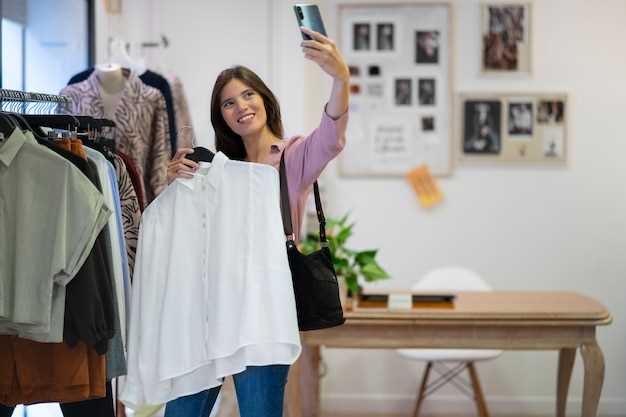
Imagine a world where the boundaries between physical and digital realms blur, where the line between reality and virtuality fades away. This is the promise of augmented reality (AR) technology in the realm of retail, a revolutionary tool that is reshaping the way we engage with products and brands.
In this digital age, consumers crave more than just the transactional aspect of shopping; they seek immersive and interactive experiences that go beyond the traditional brick-and-mortar stores. AR offers a solution by bridging the gap between the online and offline worlds, creating a seamless and engaging shopping experience that is both innovative and personalized.
The Evolution of Retail with AR
In the constant quest for innovation and enhancement of customer experiences, retailers are turning to Augmented Reality (AR) as a tool to transform their traditional business practices. AR is reshaping the way consumers interact with products and brands, creating immersive and engaging shopping experiences that are revolutionizing the industry.
Integration of Augmented Reality in Stores
Implementing AR technology into physical retail locations is rapidly changing the way consumers engage with products and brands. This integration offers a unique opportunity for businesses to create immersive and interactive experiences for shoppers, allowing them to visualize products in a new and innovative way.
- Enhanced Product Visualization: AR technology allows customers to see products in a 3D environment, giving them a better sense of how the items will look in real life.
- Personalized Recommendations: By leveraging data and AI, retailers can offer personalized product recommendations based on the shopper’s preferences and previous purchases.
- Interactive In-Store Navigation: AR applications can help customers easily navigate through the store, find specific products, and receive additional information about each item.
- Virtual Try-On: AR technology enables customers to virtually try on clothing, accessories, and makeup, helping them make more informed purchasing decisions.
Interactive In-Store Displays

Engaging In-Store Displays that allow customers to interact with products in a dynamic and immersive way are becoming increasingly important in the retail industry. These displays provide a unique and interactive experience for shoppers, enhancing their overall shopping experience and influencing their purchasing decisions.
| Benefits | Enhancements | Advantages |
| Increased customer engagement | Interactive elements | Enhanced customer experience |
| Improved product visibility | Dynamic features | Attractive displays |
| Higher conversion rates | Immersive technology | Influential marketing tool |
Interactive In-Store Displays create a memorable and personalized shopping experience for customers, making them more likely to return to the store and become loyal patrons. By combining technology and creativity, retailers can revolutionize the way shoppers engage with their products and ultimately drive sales.
Virtual Fitting Rooms

In this section, we will explore the innovative concept of virtual fitting rooms, which are changing the way consumers try on and purchase clothing online. These digital fitting rooms use augmented reality technology to allow customers to virtually try on garments and accessories, providing a more interactive and personalized shopping experience.
- Enhanced Visualizations: Virtual fitting rooms offer enhanced visualizations that allow users to see how a piece of clothing will look on them from all angles. This helps shoppers make more informed decisions when shopping online.
- Customized Recommendations: By analyzing user data and preferences, virtual fitting rooms can provide personalized recommendations for clothing items that are likely to fit and flatter the customer’s body shape.
- Convenience and Efficiency: Virtual fitting rooms save time and effort by eliminating the need to physically try on multiple items of clothing. This streamlines the shopping process and makes it easier for customers to find the perfect outfit.
Overall, virtual fitting rooms are revolutionizing the way people shop for clothing online, making it easier and more enjoyable for consumers to find the right items that fit their style and body shape. As technology continues to advance, we can expect virtual fitting rooms to become an integral part of the online shopping experience.
Enhanced Online Shopping Experiences
In this section, we will explore the ways in which digital advancements are transforming the way people engage with e-commerce platforms. The internet has provided a platform for consumers to browse, compare, and purchase products from the comfort of their own homes. With the integration of augmented reality technology, online shopping has become more interactive and immersive than ever before.
Immersive Virtual Reality:One of the key features of enhanced online shopping experiences is the use of immersive virtual reality technology. This allows customers to virtually try on clothing, visualize furniture in their homes, and even test out makeup products before making a purchase. By bringing the physical shopping experience into the digital realm, consumers can confidently make informed decisions without ever leaving their homes.
Personalized Recommendations:Another aspect of enhanced online shopping experiences is the utilization of artificial intelligence to provide personalized product recommendations based on a customer’s browsing history, preferences, and past purchases. This tailored approach not only enhances the overall shopping experience but also increases the likelihood of customers finding products that meet their specific needs and interests.
3D Product Visualization

Enhancing the Digital Shopping Experience:Imagine being able to interact with products in a virtual space, examining them from every angle and getting a true sense of their size and features. This is the power of 3D product visualization, a cutting-edge technology that is reshaping the way we shop online.
Immersive and Engaging:With 3D product visualization, customers can get a more immersive and engaging shopping experience, leading to increased customer satisfaction and higher conversion rates. Gone are the days of flat product images – now, customers can feel like they are actually interacting with the products in real life.
Personalization and Customization:Another benefit of 3D product visualization is the ability to personalize and customize products before making a purchase. Customers can see how different colors, patterns, or features will look on the product in real-time, helping them make more informed decisions.
Personalized Virtual Showrooms
In this section, we will explore the concept of customized digital display rooms that cater to individual preferences and tastes. These virtual spaces are designed to provide a unique and tailored shopping experience for each user, allowing them to interact with products in a personalized and immersive manner.
Imagine being able to browse through a virtual showroom that reflects your style, interests, and needs. Through the use of augmented reality technology, customers can customize their virtual environments, selecting everything from the color scheme to the layout of the space. This level of personalization not only enhances the shopping experience but also helps retailers better understand their customers’ preferences and behaviors.
By leveraging personalized virtual showrooms, retailers can create a more engaging and interactive shopping experience that blurs the lines between the physical and digital worlds. These virtual spaces can showcase products in a way that is visually appealing and easy to navigate, making it easier for customers to discover new items and make informed purchasing decisions. Overall, personalized virtual showrooms have the potential to revolutionize the way we shop, offering a truly unique and immersive retail experience.
Challenges and Opportunities
As we look towards the evolution of the retail landscape, we are faced with a multitude of obstacles and potential advantages. This section will explore the hurdles that must be overcome as well as the promising prospects that lie ahead in the realm of augmented reality shopping experiences.
1. Obstacles and Barriers:
- Resistance to Change
- Technical Limitations
- High Implementation Costs
- Data Privacy Concerns
- Customer Adoption Challenges
2. Potential Benefits and Opportunities:
- Enhanced Customer Engagement
- Improved Brand Loyalty
- Personalized Shopping Experiences
- Increased Sales Conversion Rates
- Competitive Advantage in the Market
Technical Hurdles to Overcome
Challenges in the technological realm obstructing the advancement and implementation of augmented reality shopping experiences are numerous and multifaceted. Various obstacles must be addressed and resolved to usher in a new era of interactive retail experiences using AR technology.
Hardware Limitations:The current state of hardware technology poses a significant challenge, as augmented reality applications require powerful devices capable of rendering high-quality graphics in real-time. Overcoming limitations in processing power, battery life, and display resolution is essential for the widespread adoption of AR in retail environments.
Software Development Complexity:Developing AR applications involves complex coding and integration processes, as well as the need for sophisticated algorithms to ensure seamless user experiences. Overcoming these challenges requires skilled developers and innovative solutions to streamline the software development pipeline.
Data Integration and Security:Integrating AR technology with existing retail systems and databases presents challenges in data management and security. Ensuring the privacy and security of customer information while providing personalized AR experiences requires robust data protection measures and compliance with regulations.
User Experience Design:Designing intuitive and user-friendly interfaces for AR applications is crucial for engaging customers and enhancing their shopping experiences. Overcoming challenges in UX design involves conducting user testing, gathering feedback, and refining interfaces to optimize usability and satisfaction.
Video:
Revolutionizing In-Store Shopping with AI and AR: Team CodePanthers Hackathon Journey!
Revolutionizing In-Store Shopping with AI and AR: Team CodePanthers Hackathon Journey! by Codepanthers 39 views 11 months ago 2 minutes, 37 seconds
FAQ:
How will AR revolutionize the shopping experience?
AR technology will allow customers to visualize products in a more interactive and immersive way, making shopping more engaging and personalized. Customers can virtually try on clothes, test out furniture placement in their homes, and see how products look in real-world environments before making a purchase.
What are some examples of how retailers are using AR to enhance the shopping experience?
Retailers are using AR to create virtual fitting rooms for customers to try on clothes without actually having to put them on, AR-powered navigation systems to help customers find products in-store more easily, and AR product visualization tools that allow customers to see how furniture and décor items would look in their own homes.
Will AR technology be accessible to all customers, or will it be limited to certain demographics?
While AR technology is becoming more prevalent, there may still be barriers to access for some customers. Factors such as the cost of AR devices and the need for high-speed internet connection may limit the accessibility of AR experiences to certain demographics. However, as the technology becomes more mainstream, it is likely to become more widely accessible.
How will AR impact traditional brick-and-mortar stores?
AR technology has the potential to enhance the in-store shopping experience by providing customers with a more interactive and engaging way to shop. Retailers can use AR to create virtual experiences in-store, such as interactive displays and AR-powered product demonstrations, to attract and retain customers in an increasingly competitive market.
What are some potential challenges or drawbacks to implementing AR technology in retail stores?
Some potential challenges of implementing AR technology in retail stores include the cost of developing and maintaining AR experiences, the need for training employees to use AR devices and systems effectively, and concerns about privacy and security when using AR technology in-store. Retailers will need to carefully consider these challenges and address them in order to successfully integrate AR into their shopping experiences.
How can AR experiences revolutionize shopping in the future?
AR experiences can revolutionize shopping by allowing customers to visualize products in their own space before purchasing them, enhancing the overall shopping experience and reducing the need for physical stores.